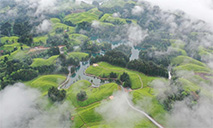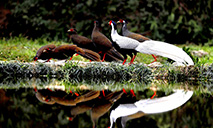Beihai city in China’s Guangxi sees increasing number of rare wild animals
The ecological environment in Beihai city in south China’s Guangxi Zhuang Autonomous Region has witnessed continuous improvement, attracting an increasing number of rare wild animals to the area, thanks to its continuous efforts in coastal ecology protection.

Photo taken in June shows the Shankou mangrove forest nature reserve in South China's Guangxi Zhuang Autonomous Region. (People’s Daily Online/Photo by Zhao Min)
On April 13, a Bryde’s whale, a first-class national protected animal in China, was seen foraging in waters off Weizhou Island in the city.
On April 9, Elysia leucolegnote, a species of mollusk, was found in a mangrove forest in Hepu county, Beihai city. It was the first time that the species was discovered in Guangxi.
The species of benthos in the city increased from 66 before 2017 to 153, including rare species such as Chinese horseshoe crabs and green sea turtles. In 2021, the city recorded 467 species of birds, an increase of 12 species compared with 2017, including a vast array of wild birds under national first-and second-class protection in China.
Between 2018 and 2021, the city poured 2.5 billion yuan (about $381.7 million) into the ecological restoration project of the Fengjiajiang River basin. As a result, an ecological barrier for the city’s coastal zones has been created. Last year, the project was named one of the top 10 ecological protection and restoration projects in the country.
The city has expanded its total area of mangrove forests by 127.11 hectares by building and restoring mangrove forests since 2017, said Cai Jinjun, Party secretary of Beihai, adding that the city’s mangrove forests had expanded to 4,210.99 hectares by the end of 2021, accounting for 45.1 percent of the total in Guangxi.
Mangrove forests play a vital role in protecting biodiversity, withstanding maritime natural disasters, and improving the coastal environment, Cai pointed out.
Photos
Related Stories
- Frequent appearances of wild animals in China indicate recent improvements to their habitats
- Rare photos of varied cast of wild creatures captured in nature reserve in C China’s Hunan
- In pics: wild animals in Gaborone Game Reserve in Botswana
- Various wild animals captured by infrared camera at nature reserve in SW China
- China’s Qilian Mountain National Park: home to a wide variety of rare wild animals
- Residents in N China's Inner Mongolia persistently protect rare wild animals
- Chinese, African experts host forum to discuss protection of wild species
- More wild animals spotted in China: official
- Wild leopard cats captured on camera for first time at a nature reserve in NW China
- Stay away from wild animals, China takes sustained action against illegal wildlife trade
Copyright © 2022 People's Daily Online. All Rights Reserved.










